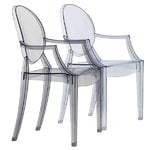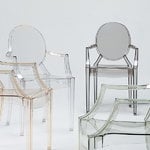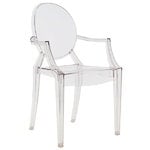Kartell's Louis Ghost chair, designed by Philippe Starck in 2002, is an iconic interpretation of the neoclassical style armchair. Louis Ghost chair has an airy and lightweight appearance yet stable and durable structure that is extremely comfortable to sit on. The classic silhouette and modern material make Louis Ghost perfect for all types of interiors and uses. The chair is stackable and also suitable for outdoor use.





Louis Ghost chair, clear
Kartell
Description
Kartell's Louis Ghost chair, designed by Philippe Starck in 2002, is an iconic interpretation of the neoclassical style armchair. Louis Ghost chair has an airy and lightweight appearance yet stable and durable structure that is extremely comfortable to sit on. The classic silhouette and modern material make Louis Ghost perfect for all types of interiors and uses. The chair is stackable and also suitable for outdoor use.
Product details (8)
- Colour
- Crystal
- Width
- 54 cm
- Depth
- 55 cm
- Height
- 94 cm
- Seat height
- 47 cm
- Armrest height
- 67 cm
- Material
- Transparent polycarbonate
- Notes
- Suitable for outdoor use
- Product ID
Designer
The french designer Philippe Starck (b. 1949) studied in École Nissim de Camondo in Paris and stayed in Paris after his studies. He became famous for his style and even the president Francois Mitterand asked him to design a suite to his palace. Starck became one of the most famous designers of that time and designed everything from apartment blocks, homes, domestic products and hotels.
Read moreReviews (0)
Sustainability
The Product Sustainability Framework, our criteria of sustainable design, helps you find the most sustainable products in our selection. Read below which sustainability criteria this product has met.
Working conditions & labour 9/9
-
Equal opportunities for all employees
-
Commitment to UN Global Compact, fair compensation for all employees
-
Corporate responsibility requirements defined and communicated for suppliers
-
Systematic work for improved inclusion and well-being in the workplace
-
Transparent supply chain
-
Suppliers' compliance to a code of conduct ensured
-
Direct suppliers audited and certified
-
Compliance to the UN Guiding Principles on Business and Human Rights ensured in the supply chain
-
Support for community involvement in the supply chain
Eco-friendly production 8/9
-
Fair and resource-wise water-use in production
-
No incineration or landfilling of returned items
-
No use of endangered species as materials
-
No direct environmental emissions or waste (excl. GHGs) from production
-
The sustainability of direct suppliers' production is addressed and monitored
-
Production and material sourcing that respect biodiversity, animal rights, and natural ecosystems
-
Material-efficient and ecological packaging
-
No potentially harmful chemicals used in own production
Climate impact 4/8
-
Company's direct greenhouse gas emissions identified and commitment to reduction
-
Product's carbon impact identified and commitment to reduction
-
Guidance on energy- and eco-efficient use of the product
-
Contribution to climate initiatives beyond the brand’s direct operations
Sustainable materials 6/6
-
Sustainable and long-lasting material choices
-
No harmful or hazardous substances
-
Responsible raw material sourcing and production
-
Materials suited for circularity: monomaterials, recyclable finishings, renewable or recycled contents etc.
-
Ecological materials: natural, biodegradable, recyclable or recycled contents
-
Outstanding materials in terms of innovativeness, responsibility, sustainability and circularity: local production or sourcing, 100 % recycled content, C2C-certification etc.
Circular design 4/5
-
High aesthetic quality promoting long-term use of the product
-
Technically durable product design and material choices
-
Design for enduring life-long quality
-
Design and support for product maintenance, repair and upgradability








